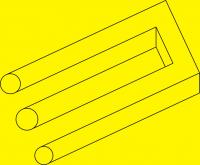4th Axis rotary
22 Feb 2011 11:55 #7375
by Rick G
Replied by Rick G on topic Re:4th Axis rotary
Hello John,
The more I read it the clearer it becomes to me. I think the description is written with an economy of words and is precise.
I certainly do not think I could do any better. I do think however an example would be helpful.
I would be glad to write a short example if you feel it would be helpful.
Rick
The more I read it the clearer it becomes to me. I think the description is written with an economy of words and is precise.
I certainly do not think I could do any better. I do think however an example would be helpful.
I would be glad to write a short example if you feel it would be helpful.
Rick
Please Log in or Create an account to join the conversation.
22 Feb 2011 11:58 #7376
by BigJohnT
Replied by BigJohnT on topic Re:4th Axis rotary
LOL, yes it is written in "programmer speak" an example would be good. Chris suggested that he might need to use G93. He also noticed that a tool change was done without a G43!
John
John
Please Log in or Create an account to join the conversation.
22 Feb 2011 12:20 #7377
by Rick G
Replied by Rick G on topic Re:4th Axis rotary
judedude,
From what I understand this is a G code thing not something that is unique to EMC.
You could set G94 and a F speed
G94
F20
run all the lines that combine linear and rotary motion.
then
Set G95 and a rotary F speed
G95
F200
run the lines that are rotary only
then set G94 and a F speed again
If the lines only occur a few places edit by hand.
If the lines occur often a change in the post processor with be a better solution.
By the way if there was only a very slight movement in say X,Y, or Z (.0001) combined with the rotary movement the rotary axis would move at high speed to the commanded position.
Rick G
From what I understand this is a G code thing not something that is unique to EMC.
You could set G94 and a F speed
G94
F20
run all the lines that combine linear and rotary motion.
then
Set G95 and a rotary F speed
G95
F200
run the lines that are rotary only
then set G94 and a F speed again
If the lines only occur a few places edit by hand.
If the lines occur often a change in the post processor with be a better solution.
By the way if there was only a very slight movement in say X,Y, or Z (.0001) combined with the rotary movement the rotary axis would move at high speed to the commanded position.
Rick G
Please Log in or Create an account to join the conversation.
22 Feb 2011 12:30 #7378
by Rick G
Replied by Rick G on topic Re:4th Axis rotary
John,
I have seen G93 suggested for this before but I have never tried it.
I will put together an example of G94 and G95 sometime soon.
As luck would have it it snowed...again, so I will be working on that.
Have a good one,
Rick
I have seen G93 suggested for this before but I have never tried it.
I will put together an example of G94 and G95 sometime soon.
As luck would have it it snowed...again, so I will be working on that.
Have a good one,
Rick
Please Log in or Create an account to join the conversation.
22 Feb 2011 17:56 #7382
by judedude
Replied by judedude on topic Re:4th Axis rotary
Rick,
Basically the distance a tool needs to travel around the OD will vary depending on diameter of the work. Therefore a velocity with a small diameter will not be the same as with a big diameter. Is there a way to define / re-define the configuration diameter so the feed rate is adjusted with diameter of the work.
Basically the distance a tool needs to travel around the OD will vary depending on diameter of the work. Therefore a velocity with a small diameter will not be the same as with a big diameter. Is there a way to define / re-define the configuration diameter so the feed rate is adjusted with diameter of the work.
Please Log in or Create an account to join the conversation.
23 Feb 2011 10:33 #7399
by Rick G
Replied by Rick G on topic Re:4th Axis rotary
If you are using the spindle of a lathe you can use G96 constant surface speed.
Rick G
Rick G
Please Log in or Create an account to join the conversation.
Time to create page: 0.541 seconds


